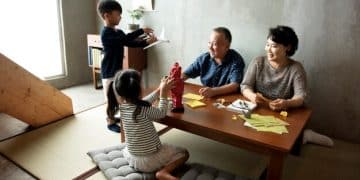Understanding Korean Workplace Culture: Tips for US Professionals in 2025

Understanding Korean workplace culture in 2025 is crucial for US professionals, requiring adaptation to hierarchical structures, communication styles, and after-work activities to foster successful collaborations and career growth.
For US professionals aiming for success in South Korea, understanding Korean workplace culture: tips for US professionals in 2025 is no longer a luxury, but a necessity. Prepare to navigate a landscape shaped by unique traditions and expectations.
Embracing the Korean Work Ethos: A Foundation for Success
Entering the Korean workplace requires more than just professional skills; it demands an understanding of the deeply ingrained cultural values that shape daily interactions and expectations. This ethos, while different from that in the US, can be navigated successfully with awareness and respect.
Here’s how to prepare and thrive:
Hierarchy and Respect
Korean workplaces typically adhere to a strict hierarchical structure. Age and seniority play a significant role, influencing communication and decision-making processes. It’s important to be aware of your position within the hierarchy and show appropriate deference to those above you.
Collectivism vs. Individualism
While US culture often emphasizes individualism, Korean workplace culture is heavily influenced by collectivism. Teamwork and group harmony are prioritized, and individual accomplishments are often recognized within the context of the team’s success.
- Show Respect: Use appropriate titles and honorifics when addressing superiors.
- Value Harmony: Participate actively in team activities and strive to maintain positive relationships with colleagues.
- Be Patient: Decisions may take longer due to the emphasis on consensus-building.
By understanding and respecting these core values, US professionals can build strong relationships and navigate the Korean workplace with greater ease.
Decoding Communication Styles: Beyond the Spoken Word
Effective communication is crucial in any workplace, but in Korea, it extends beyond the literal meaning of words. Understanding the nuances of Korean communication styles can help US professionals avoid misunderstandings and build stronger rapport with colleagues.
Mastering these nuances is crucial:
Indirectness and Context
Direct communication, while common in the US, can be perceived as rude or confrontational in Korea. Koreans often rely on indirectness and context to convey meaning, requiring careful attention to nonverbal cues and implied messages.
Saving Face (체면 – Che-myeon)
“Saving face” is a central concept in Korean culture. It refers to protecting one’s own and others’ dignity and reputation. Avoiding public criticism or embarrassment is crucial to maintaining harmonious relationships.

- Listen Actively: Pay attention to both verbal and nonverbal cues.
- Be Mindful of Tone: Avoid being overly direct or confrontational.
- Offer Praise Publicly, Criticize Privately: This helps maintain harmony and avoid embarrassing anyone.
Adapting to these communication styles demonstrates cultural sensitivity and fosters stronger professional relationships.
Navigating 회식 (Hoesik): After-Work Socializing
Hoesik, or after-work socializing, is an integral part of Korean workplace culture. These gatherings provide opportunities to build relationships and foster team camaraderie. While participation is often expected, it’s important to approach hoesik with an understanding of the cultural norms involved.
Here’s a quick guide to navigating hoesik:
Expected Participation
While not always mandatory, declining hoesik invitations too frequently can be seen as a sign of disinterest in building relationships with colleagues. Try to participate when possible, even if it’s just for a short period.
Drinking Etiquette
Drinking is a common activity during hoesik. It’s important to be aware of the drinking etiquette, such as pouring drinks for others and accepting drinks offered by superiors with both hands.
Building Relationships
Hoesik offers a valuable opportunity to connect with colleagues on a more personal level, fostering stronger working relationships. Use this time to engage in conversation and show genuine interest in getting to know your teammates.
Remember to pace yourself, be mindful of your behavior, and use hoesik as an opportunity to build bridges with your Korean colleagues.
The Importance of Relationships (인맥 – In脈)
In Korea, relationships, or in脈 (in-mac), are crucial for professional success. Building a strong network of colleagues, mentors, and contacts can open doors to opportunities and provide valuable support throughout your career.
Cultivating in脈 is key to long-term success:
Building Trust and Rapport
Investing time and effort in building genuine relationships is essential. Be proactive in getting to know your colleagues, offering assistance, and showing genuine interest in their well-being.
Networking Opportunities
Actively participate in networking events and industry gatherings to expand your circle of contacts. Remember to maintain these relationships through regular communication and follow-up.

- Attend Company Events: Participate in team outings and social events to build camaraderie.
- Seek Mentorship: Find a mentor who can provide guidance and support as you navigate the Korean workplace.
- Stay Connected: Maintain contact with colleagues even after you change jobs or leave the country.
By prioritizing relationships and actively cultivating your in脈, you can create a strong foundation for professional growth in Korea.
Adapting to the Pace of Work: Patience and Persistence
The pace of work in Korea can differ significantly from that in the US. US professionals may need to adjust their expectations and develop patience and persistence to thrive in this dynamic environment.
Key aspects to consider:
Longer Working Hours
Korean workplaces are known for their long working hours. While this may be changing, it’s important to be prepared for a demanding schedule.
Emphasis on Speed and Efficiency
Despite the long hours, there’s also a strong emphasis on speed and efficiency. US professionals should strive to be productive and meet deadlines effectively.
By adapting to the pace of work and demonstrating commitment and perseverance, US professionals can earn the respect of their Korean colleagues and achieve success in their careers.
Leveraging Cultural Differences: A Source of Innovation
While adapting to Korean workplace culture is important, it’s equally important to recognize and leverage the value of cultural differences. By bringing your unique perspective and skills to the table, you can contribute to innovation and creativity within the organization.
Here’s how to leverage your unique background:
Sharing Ideas and Perspectives
Don’t be afraid to share your ideas and perspectives, even if they differ from the norm. Your unique insights can provide valuable contributions and help the team think outside the box.
Promoting Cross-Cultural Understanding
Actively promote cross-cultural understanding by sharing your knowledge of US culture and values with your Korean colleagues. This can help bridge communication gaps and foster a more inclusive work environment.
Embracing diversity and leveraging cultural differences can lead to greater innovation, creativity, and overall success for both individuals and organizations.
Conclusion: Embracing the Journey
Navigating the Korean workplace as a US professional in 2025 presents both challenges and opportunities. By understanding Korean workplace culture: tips for US professionals in 2025, respecting cultural norms, building relationships, and leveraging your unique skills, you can create a rewarding and successful career in South Korea. Embrace the journey, be open to learning, and celebrate the richness of cross-cultural collaboration.
| Key Point | Brief Description |
|---|---|
| 🤝 Respect Hierarchy | Acknowledge seniority and use appropriate titles. |
| 🗣️ Communication | Be mindful of indirectness and context. |
| 🍻 Hoesik | Participate in after-work socializing when possible. |
| 🌐 Build In脈 | Network and cultivate relationships to build influence. |
Frequently Asked Questions
▼
Hierarchy and respect are paramount. Understanding the importance of seniority and using proper titles is crucial for navigating social and professional interactions successfully, fostering positive relationships.
▼
Practice indirect communication, paying attention to nonverbal cues. Avoid direct confrontation, focusing on maintaining harmony and “saving face” to build trust and avoid misunderstandings.
▼
While not strictly mandatory, regular participation is highly encouraged. It’s an opportunity to build relationships, so attending periodically is beneficial, showing your commitment to the team and workplace culture.
▼
인맥 (in脈) refers to one’s network and relationships. Building a strong 인맥 is crucial for career advancement in Korea, opening doors to opportunities and providing support within a close-knit professional community.
▼
Share your unique perspectives respectfully. Propose innovative solutions and promote cross-cultural understanding. This fosters a more diverse and creative environment, contributing to mutual learning and organizational success.
Conclusion
For US professionals stepping into the Korean workplace of 2025, embracing cultural nuances is key. By showing respect, adapting communication, engaging socially, building networks, and leveraging unique perspectives, professionals can thrive in a Korean workplace, enhancing collaboration and success.





